euNeed to know about pneumatic tires for forklifts and other industrial equipment?
Then you’re in the right place because we have put together the ultimate guide!
Keep scrolling to explore everything you need to know about pneumatic tires, such as:
- What pneumatic tires are
- Their pros and cons
- The different types of pneumatic tires
- What applications pneumatic tires are good fits for
- How much do pneumatic tires cost
- And lots more! That includes checking the tires.
Let’s dive in!
What Are Pneumatic Tires?
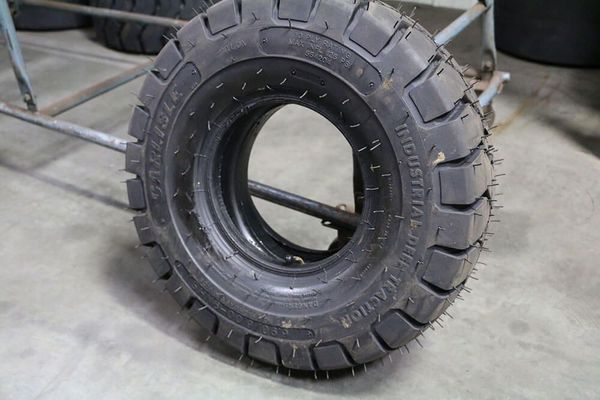
Let’s start with a pneumatic tire definition.
Pneumatic rubber tires are the standard type of tire that people are familiar with, commonly found on your average car or truck.
But pneumatic tires are also commonly found on different types of industrial equipment, like forklifts and aerial lifts.
This article will focus on pneumatic tires for forklifts specifically.
Pneumatic tires on forklifts are suitable for operation in both indoor and outdoor environments. However, they are most effective in areas devoid of sharp objects that could puncture or deflate the tires.
Some key characteristics of pneumatic forklift truck tires are:
- Thick rubber to support the weight of the vehicle.
- Thick treads for better traction for driving and braking.
- Better traction on irregular terrain.
These characteristics determine the performance and durability of pneumatic tires.
Pneumatic Forklift Tires and Other Tire Types
There are four main forklift tire types:
- Pneumatic tires (also called “air pneumatic”)
- Solid pneumatic tires (sometimes referred to as “foam-filled”)
- Cushion tires (also called “press-on”)
- Polyurethane tires (or “poly” for short)
Let’s discuss them in detail below.
Pneumatic Forklift Tires
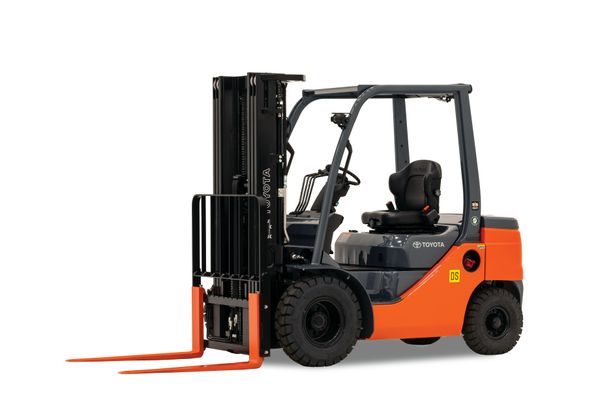
A pneumatic tire is just like a regular inflatable car tire. As such, they’re primarily outdoor forklift tires.
The outer tread and sidewalls of pneumatic tires contain a combination of synthetic or natural rubber, along with layers of fabric and wire. The interior of a pneumatic tire is usually empty and allows for an inner tube filled with compressed air to sit inside, keep its form, and support truck movement. The tire is attached to a metal hub linked to the axle to ensure stability and support.
The tire is filled with air to a specified pressure level based on the manufacturer’s instructions or use. The air allows the tire to handle an appropriate load and perform its function on different types of terrain.
Pneumatic forklift tires are available in various sizes tailored to different industrial machines and applications. They are the preferred tire for their rubber treads and excellent shock absorption capabilities, which aid in stabilizing the machine and minimizing bumps and jolts during use.
Cushion Forklift Tires
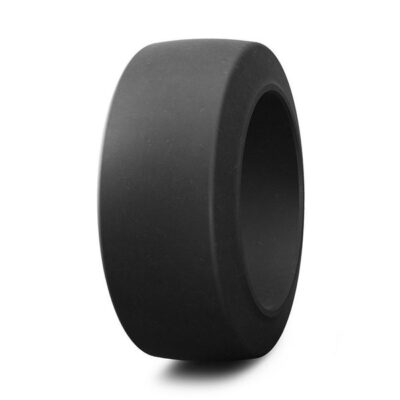
Cushion tires, known alternatively as press-on-tires, are solid rubber tires molded onto a thin metal (usually steel) band. The tread of cushion tires is solid rubber, offering the choice of grooved or smooth patterns.
Cushion tires are used on indoor tire forklifts, specifically designed for smooth, flat surfaces like concrete floors, making them well-suited for indoor settings like warehouses and factories. Additionally, they enable a smaller turning radius, making them ideal for maneuvering in tighter spaces.
Though designed primarily for indoor use, cushion tires are durable and allow for some light use outdoors on smooth surfaces.
Solid Pneumatic Forklift Tires
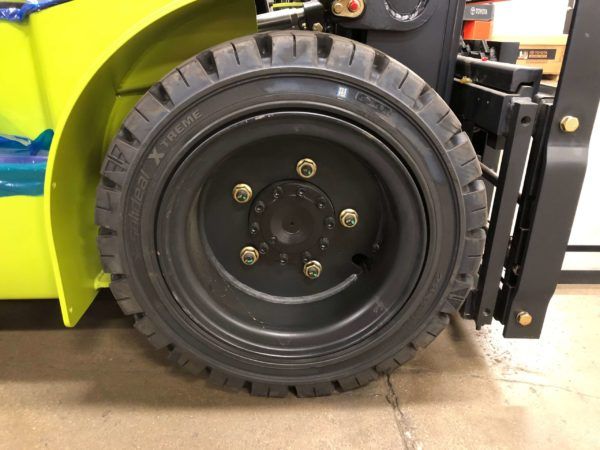
Solid pneumatic tires (also called “foam-filled” tires) are a type of pneumatic tire. But instead of the air-filled inner tube, the hollow inner side is filled with foam. Because of the foam, this tire type falls between air-filled pneumatic tires and cushion tires. The foam in solid pneumatic tires makes them solid and hardened, hence the name “solid tires.”
Many operations use foam-filled tires for heavy equipment because they cannot be deflated from punctures like air-filled tires can be. Being puncture-proof makes them excellent choices for operations with lots of sharp debris, like scrap yards, construction sites, and lumber operations.
Polyurethane Forklift Tires
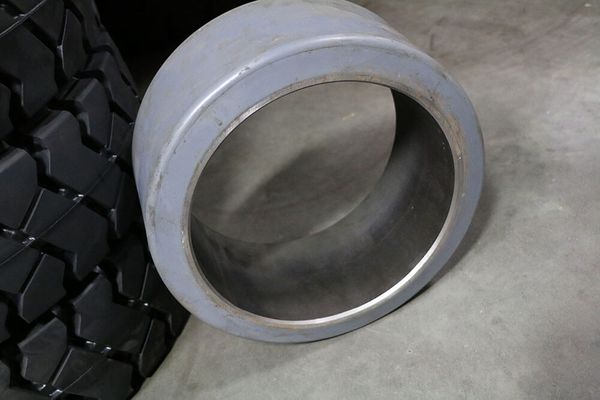
Polyurethane tires are a type of press-on tire that’s lightweight and resistant to splitting, tearing, and chunking out under a load.
They combine good traction with low-rolling resistance in any operation and are durable.
Overall, polyurethane tires experience about twice the lifespan of pneumatic rubber tires and should be used indoors only for light applications like warehousing. That said, polyurethane tires are generally found on lift trucks like order pickers, pallet jacks, and reach trucks (as opposed to sit-down rider forklifts).
Non-Marking Forklift Tires
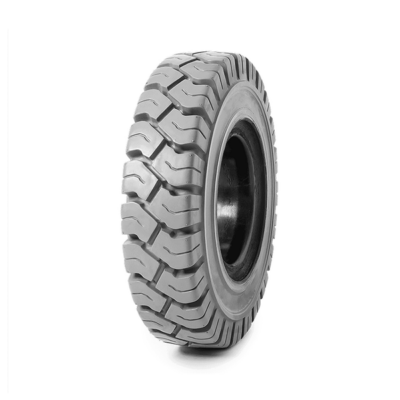
Non-marking tires are a tire type made with hydrated silicas and special additives that prevent marking the floors.
Depending on the forklift model, you can choose non-marking treads for pneumatic, solid pneumatic, or cushion tires.
Non-marking tires wear out faster than carbon-black tires and can build up static electricity, requiring an anti-static strap on the forklift to prevent discharges.
Pneumatic Forklift Tire Applications
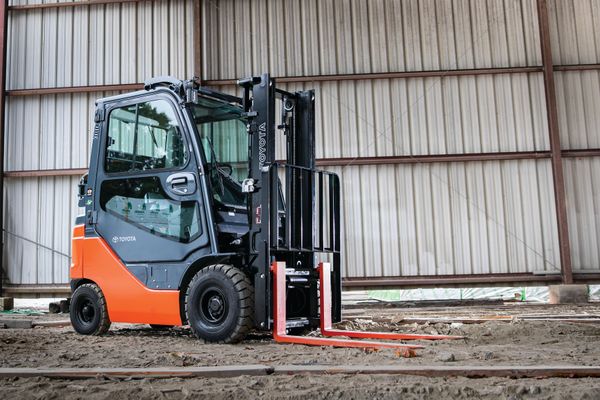
Air-filled pneumatic tires are better suited for outdoor use where there’s less debris and fewer sharp objects to puncture or deflate. Locations like scrap yards may want to avoid using them. Extended indoor use of air-filled pneumatic tires can lead to operator discomfort due to bouncing and a generally less comfortable driving experience.
Pneumatic tires excel on rough terrains, making them ideal off-road tires for forklifts. The larger frames and flexible nature of air-filled pneumatic tires enable them to conform to irregular terrains, providing superior grip. This feature makes them well-suited for construction sites, logging areas, and lumber yards.
Solid pneumatic tires work well in applications with lots of sharp debris, scrap yards, recycling plants, and select construction sites. Their solid foam filling prevents deflation, distinguishing them from tires with air-filled inner tubes.
Air-filled pneumatic tires find common usage on sit-down style internal combustion forklifts, especially heavy-duty models.
Pros of Pneumatic Forklift Tires
Here are some advantages of pneumatic tires to consider:
- Smooth ride on uneven terrains: In outdoor environments, especially on terrains that are less than perfectly even, like gravel, pneumatic tires can make for a much smoother ride.
- Shock absorption: Pneumatic tires’ shock absorption makes them ideal for job sites with bumpy terrains or when the loads need protection from sudden shocks.
- Comfortable operation. Better shock absorption also helps provide smoother rides, less operator fatigue, and better comfort.
- Better traction for versatility: Pneumatic tires offer superior traction, making them versatile for various applications. They perform well on uneven terrain, indoors, on pavement, and off-road. Their enhanced grip provides better stability and reduces slippage on gravel, dirt, and grass surfaces.
- Less prone to damaging flooring: The nature of the softer pneumatic wheel also protects warehouse floors from scratches and other possible damage.
- Better maneuverability: The higher profile of pneumatic tires affords higher ground clearance, making them superior for operating on rough terrains like gravel.
- Less expensive: Pneumatic tires are usually cheaper than solid pneumatic or cushion tires.
Cons of Pneumatic Forklift Tires
Here are some disadvantages of pneumatic tires to consider:
- Not ideal for indoor use: Pneumatic tires may not be optimal for indoor use due to their tendency to bounce, leading to operator discomfort.
- Susceptible to deflation/puncture: Pneumatic tires can be popped by pricks from debris and sharp objects (metal, screws, nails, etc.), causing their deflation. So, if you’re in an environment liable to have those items on the ground, you may need to reconsider your selection of pneumatic tires.
- Requires air pressure maintenance:
- Pneumatic tires are susceptible to air loss through deflation or tube malfunction, necessitating regular air pressure maintenance. In contrast to solid pneumatic tires (foam-filled) or solid cushion tires, which do not lose air, pneumatic tires require monitoring of air levels and attention to valve stems.
How to Convert Pneumatic Forklift Tires to Solid
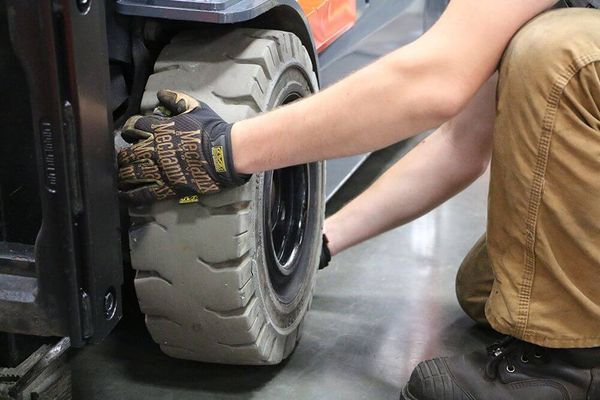
The general procedure for converting pneumatic forklift tires to solid, foam-filled tires involves:
- Wheel Removal: Take off the wheel from the forklift.
- Tire Cleaning: Ensure the tire’s interior is clean and free of any liquids like tire sealant or water that could interfere with foam filling.
- Foam Filling: Inject a 2-component liquid urethane into the tire through the valve stem.
- Sealing: Seal off the valve stem after the foam fill injection.
- Curing: Let the tire lay flat for the liquid to solidify for the required period (24 hours to a couple of days), replacing any remaining air.
Be aware of the downsides of converting pneumatic forklift tires to solid.
For example, the curing process can take a couple of days. That means your forklift will be down and out of commission for that long. If downtime is a problem, you might want to replace your existing pneumatic tires with new solid pneumatics.
Need Help Converting Your Air Pneumatic Forklift Tires to Solid Pneumatic?
Converting forklift pneumatic tires can be challenging, so we recommend having it done by an experienced tire specialist. They possess the necessary knowledge, experience, and equipment to perform the conversion safely and effectively.
When considering converting your forklift tires, we are ready to assist you.
Where to Buy Pneumatic Tires for Forklifts and Other Industrial Equipment
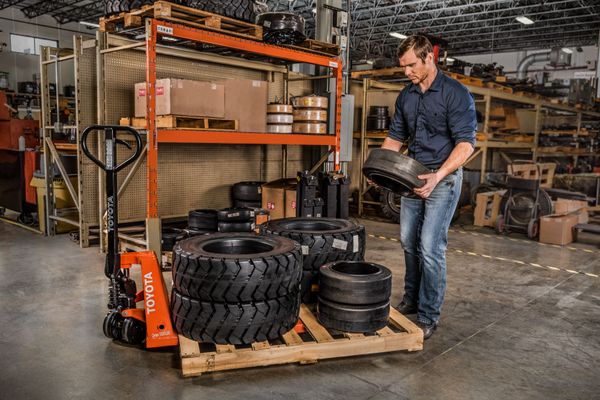
Where you buy your forklift tires is as important as the tires you buy. Why?
You want to get quality and genuine tires from top forklift tire companies. You can also benefit from after-sales support, such as expert support in installation and maintenance.
So, always be careful where you get your tires. That means keeping in mind to look for vendors that:
- Have a positive reputation.
- Offer high-quality tires.
- Have tires that are compatible with your equipment.
- Offer competitive pricing.
- Have robust after-sales support.
This process ensures you get quality tires at affordable prices and benefit from any needed support for use or installation.
With that said, here are the two main ways to acquire pneumatic tires for your forklift or other industrial equipment:
- Buy from an authorized forklift dealer
- Buy from an E-commerce retailer
Let’s go through each option so you can make an informed decision.
1. Authorized Equipment Dealerships

You can get pneumatic tires from authorized industrial equipment dealerships (like Conger Industries).
Dealerships provide comprehensive solutions for industrial equipment needs. Purchasing from a dealership grants access to material handling experts who can assist in determining your requirements and troubleshooting any issues. By collaborating with these experts, they can facilitate the selection, ordering, installation, and ongoing maintenance of tires for your application.
Dealerships are a one-stop, turnkey solution for all your industrial equipment needs.
2. E-Commerce Retailers

You can also buy pneumatic forklift tires from online retailers. To do this, google “buy forklift tires online” and choose from the results. Once you spot a suitable retailer, you can go to the retailer’s website and buy from there.
While this avenue offers convenience, it may not always be straightforward. Especially if you’re not sure exactly what you’re looking for.
For example, minimizing overhead is the key for many online retailers to remain in business. And that may mean customer service ends up on the “chopping block.” The result? You may be on your own to figure out your forklift tire needs, make sure they’re compatible, order, install, and so on.
Contact Conger Industries for Your Pneumatic Forklift Tire Needs
Do you need pneumatic forklift tires or any other type of tire?
Grab your equipment make, model, and serial number, get a hold of us, and we’ll be happy to walk you through the process and ensure you get the right tires.
We’ll arrange a visit to your site, assemble all components, install the tires, and set up ongoing maintenance. Our tire professionals excel at delivering excellent service with minimal downtime, ensuring you’re swiftly back up and running.
Pneumatic Forklift Tire Maintenance: Everything You Need to Know
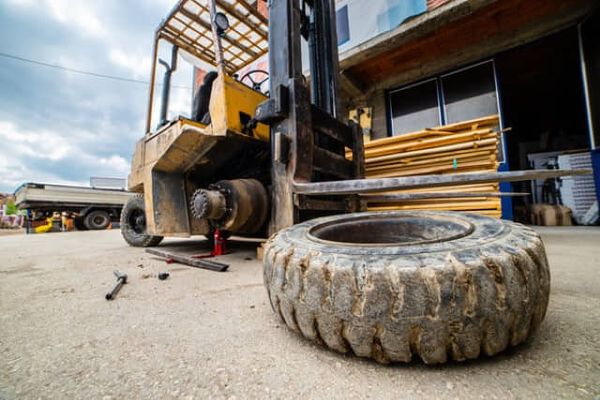
Note: Specific pneumatic tire maintenance requirements can differ from tire to tire. Always check with the tire manufacturer to determine their specific requirements. You can also get advice from tire specialists like those with Conger Industries. They can provide valuable insights and recommendations tailored to your tires.
Heavy or industrial equipment tires are expensive. To make your tires last longer, they will need regular tire maintenance.
Proper tire maintenance for industrial equipment should involve the following activities:
- Understand your tire type.
- Operator training on tire maintenance.
- Visual tire inspection.
- Check tire pressure.
- Check tread wear/depth.
- Tire rotation.
- Perform scheduled maintenance.
- Encourage good driving habits.
- Implement tire tracking practices.
Let’s look at each in more detail.
1. Understand Your Tire Type
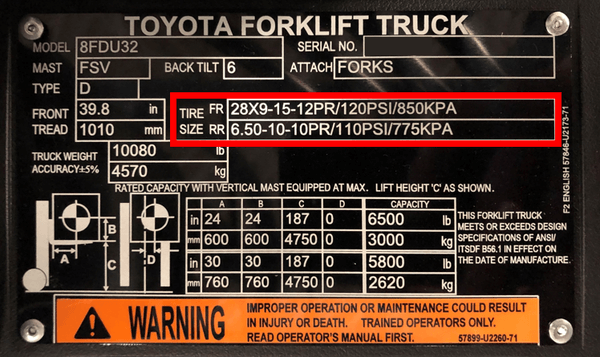
The starting point of pneumatic tire maintenance is ensuring the correct tire type is on the right equipment. That will promote machine stability and worksite safety.
A warehouse or construction worksite is already dangerous, so ensure your forklifts have the appropriate tire type to prevent additional hazards.
Check the manufacturer’s recommendation on tire type and confirm that it should use pneumatic tires. If it should use a different tire type or has a different tire installed, contact the manufacturer or dealer and have them clarify or rectify it.
Also, avoid using different types of tires simultaneously on your industrial vehicle. It can help prolong your equipment’s life cycle and tires. And you won’t have to spend more on forklift repairs or tire maintenance.
2. Train Employees on Tire Maintenance
First, never allow workers to operate a forklift or industrial truck without OSHA-compliant training.
Providing comprehensive training gives operators theoretical and practical knowledge of tire maintenance for operating their equipment. They will also understand how to use forklift safety tools and equipment during tire maintenance.
While operators may be familiar with car tires, industrial equipment tires are more demanding and require training and techniques.
So, before you assign your employees to carry out tire maintenance, you must ensure they understand:
- Theoretical and practical tire maintenance knowledge: You could write a manual or have a qualified mechanic demonstrate the procedure to them. Employees should know what to look for when inspecting forklift tires.
- Maintenance tools and equipment: Cover all tools used in tire maintenance.
- Tire pressure adjustment procedures: Ensure employees understand these procedures thoroughly, as they are a fundamental aspect of pneumatic tire maintenance.
- Tire maintenance safety: A tire can explode if overinflated. Employees should know safe positions for inflation that place them outside the danger zone to lower the chance of injury.
3. Conduct Regular Visual Tire Inspections
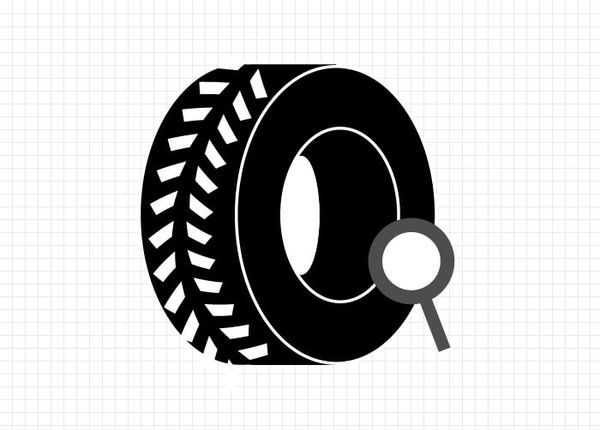
An inspection can help prevent forklift accidents and prolong the equipment’s useful life.
That includes checking the tires. OSHA notes that operators must conduct pre-operation forklift inspections “at least daily” to check “[t]ire condition and pressure including cuts and gouges.” Any deficiencies must be addressed” before operating the fork truck.
In general, the visual inspection should include:
- Tire pressure at the start of each workday. Underinflation or overinflation can lead to tire blowouts. Check for low tire pressure, which can feel like a spongy drive.
- Physical tire damage (such as cracks or punctures.)
- Sidewall integrity.
- Tire chunking.
- Worn treads (cuts and bulges.)
- Dirt or substance buildups.
- Ensure the tire nozzle is fitted and functioning.
- Ensure that tire valve caps are securely in place.
Additionally, operators should remove from the floor any hazards (debris, potholes, liquids, etc.) that could affect the tire’s integrity before operating their lift truck.
4. Check Tire Pressure Regularly
Make sure operators check and correct pneumatic tire pressure during the inspection. Why?
There are two reasons to make sure the forklift tire pressure is correct:
- Underinflation builds up heat, which expands the tire and can cause the tire to fail.
- Overinflation makes tires vulnerable to impact and accelerates wear.
Proper pneumatic tire pressure can ensure optimal traction and braking capability.
Check the manufacturer’s recommendations to determine the correct pressure.
Kicking the tire to check the inflation doesn’t work. Instead, use a reliable tire pressure gauge and adjust the tire pressure as needed.
5. Check Tire Tread Wear and Depth
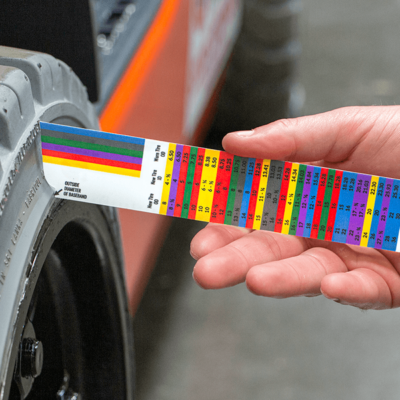
During pneumatic tire inspection, you should also check and measure tire tread depth depending on the pneumatic tire tread styles.
If the treads are too thin, the tire won’t provide traction.
Refer to the manufacturer’s guidelines to determine the maximum allowable wear. Once the tread reaches that point, replace the tire.
6. Ensure Consistent Tire Rotations
Regularly Rotating your forklift tires can help even out tire wear and prevent premature wear like:
- Side wear (shoulder wear on both sides).
- Center wear.
- One-sided wear.
- Diagonal wear.
- Flat spots.
7. Perform Scheduled Maintenance
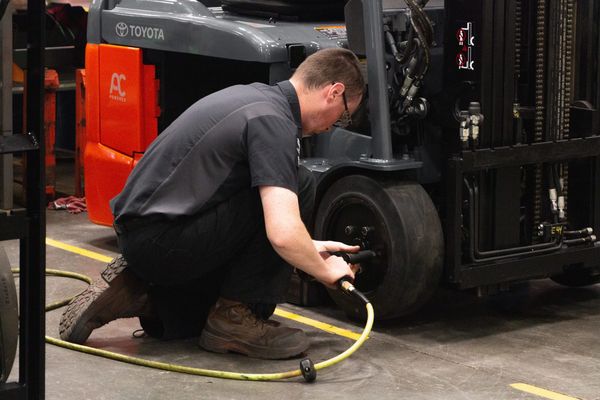
Staying on top of recommended manufacturer maintenance checks to keep the tire in optimal operating condition, prevent premature failure, and reduce safety risks. Regular maintenance also helps reduce tire repair costs and ensures proper maneuverability.
Ensure your forklift maintenance schedule includes regular tire inspections and maintenance as well. If your current plan doesn’t, you may want to reach out for help maintaining your lift truck tire integrity.
8. Encourage Good Driving Habits
To keep your forklift tires functional for as long as possible, advise your operators to avoid the following driving habits:
- Ignoring maintenance.
- Neglecting tire pressure.
- Driving at top forklift speed.
- Carrying excessive loads.
- Cornering and braking instantly and harshly.
- Driving haphazardly.
Good driving and operating habits will protect your pneumatic tires longer. You can also spend less fuel and enhance vehicle and warehouse safety.
9. Implement Tire Tracking Best Practices
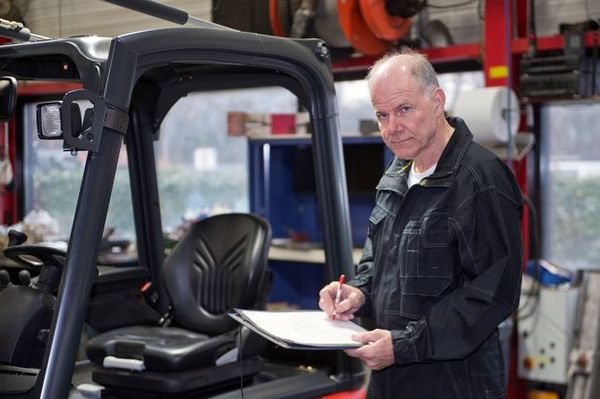
Lastly, since you put a lot of effort into selecting, purchasing, and maintaining tires, tracking is the best way to ensure longevity.
With tire tracking, you’ll get data to base your future tire-related decisions.,
Record each purchase, repair, maintenance, or replace a tire. Alternatively, use a tire tracker solution like GoCodes to keep these records.
If you record your tire’s purchase date, you can calculate its replacement dates based on repairs and maintenance needs.
Analyzing this tracking information can help you determine if your operators have bad driving habits or if their habits align with the manufacturer and your needs.
Tire tracking can also help you understand tire maintenance schedules based on use.
Common Pneumatic Forklift Tire Questions
What Is the Difference Between Pneumatic Tires and Regular Tires?
A “regular” tire is a pneumatic tire. Regular tires are typically air-filled, which is what “pneumatic” means.
What Is the Difference Between Pneumatic Wheels and Rubber Wheels?
When comparing solid rubber vs pneumatic wheels, “rubber wheels” generally mean the same as “cushion tires.” These are solid rubber treads that are adhered to an inner metal band.
On the other hand, pneumatic wheels are composed of an outer, relatively thin layer of rubber tread and an inner hollow core containing an air-filled inner tube. This piece of the tire is fitted around an inner metal hub and bolted to the axle.
Why Are Pneumatic Tires Used on Outside Forklifts?
Pneumatic tires have thick rubber treads to boost traction, absorb shocks, and stabilize vehicles. They grip well on uneven surfaces and rough terrain, reducing bumps and shaking. They are commonly on outdoor forklifts at construction sites, lumber yards, and outdoor warehouses.
What Are the Benefits of Pneumatic Tires?
Pneumatic tires have high shock absorption capabilities, better traction, less reduction, and more durability. Their ability to absorb the unevenness of terrain allows for a smoother ride and less bumping and shaking.
How Long Do Pneumatic Forklift Tires Last?
With regular, full-time use, forklift tires should last about a year. How long any particular tire will last depends on usage, work environment, maintenance, and driving styles.
In general, pneumatic tires tend to wear out sooner than solid pneumatic tires. Plus, they can be punctured, causing a flat tire, which will need patching and may cause quicker wear.
Do Pneumatic Tires Go Flat?
Pneumatic tires, filled with air, are prone to punctures and deflation, requiring regular air pressure checks and refills to maintain proper inflation.
Are Pneumatic Tires Puncture-Proof?
Air pneumatic tires are filled with air, making them puncture-prone. They can puncture easily from a stray nail, a pointy stone, or other objects. The solid pneumatics (foam-filled pneumatics) contain rubber-filled foam, making them more puncture-proof.
Can You Make Pneumatic Forklift Tires Solid?
It may be possible to convert air-filled tires to solid tires by filling them with a liquid that hardens inside the tire. For example, foam-filled tires are pneumatic tires filled with a liquid that hardens and replaces the air in the tire.
Do Pneumatic Tires Have Inner Tubes?
Air-filled Pneumatic tires have a separate inner tube made of rubber situated between the wheel hub and the outer tread. This inner tube is designed to hold air, much like a balloon.
Solid Pneumatic forklift tires, on the other hand, are filled with solid foam. These tires can be called “tubeless pneumatic tires.”
Do Pneumatic Tires Need Air?
Pneumatic tires, also known as “air-filled tires,” maintain their round rubber shape and structure because they air. The inside of a pneumatic tire is hollow, allowing air to sit inside and maintain its form.
But there are also foam-filled pneumatic tires (called “solid pneumatics”) that are full of foam. These tires don’t need air.
Conclusion
That’s it: Your ultimate guide to pneumatic tires!
![Pneumatic Tires [Definition, Pros/Cons, Applications, Costs]](https://www.conger.com/wp-content/uploads/2023/07/Pneumatic-Tires.png)